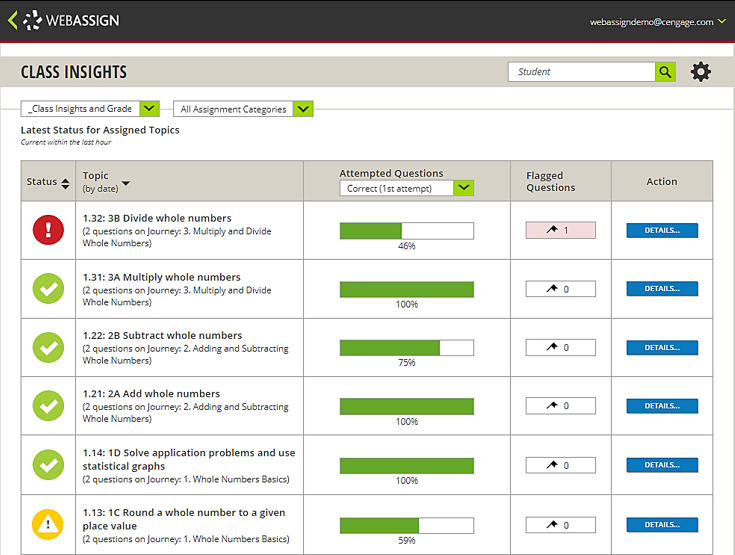Article Summary
- Review My Class Insights data regularly and customize your lectures & assignments to the topics that need the most work. Save yourself time and support your students’ specific needs!
- Use My Class Insights to identify and support students with low performance.
- Test & learn! My Class Insights enables you to try new teaching or student intervention methods as well as measure the success of them. Find out what works best with your students by trying one of these tips!
Student analytics is a great tool to have, but you need a goal to use it effectively. With Class Insights, you can evaluate student performance on questions and topics throughout the semester and use it in your course lectures and assignments. Let’s look at seven ways you can make the most of Class Insights to save valuable prep time, while enhancing student performance.
1) Identify and Address Concepts Students Don’t Understand
Student understanding goes beyond an assignment score. Class Insights enables you to quickly identify which textbook topics are confusing your students, based on the number of attempts to correctly answer questions. Using this data can help save you time; here are some ways to use it:
- Schedule a diagnostic test at the beginning of the semester to determine how much time you’ll need to spend reviewing prerequisite topics. This will help you tailor your lectures to prioritize and review the prerequisite topics your students need more work on.
- Before an exam, identify which topics need additional support or coverage to make sure your students are prepared by checking student progress by topic within Class Insights.
WebAssign Tip: Begin each new chapter by scheduling a quiz to assess how well your students understand the material before. Then, schedule the same quiz at the end of the chapter. Compare the results to assess conceptual understanding and identify areas students may need to work on before the final exam.
2) Review Challenging Homework Topics
Use the Class Insights overview to review homework and pinpoint flagged questions that caused trouble for a large percentage of the class. We recommend:
- Take the first five minutes of class to review these flagged questions with your students, or create a short video lecture going over the questions and assign it to your students to watch.
- Reassign flagged homework questions on practice assignments, or build a practice test before an upcoming exam with these questions.
WebAssign Tip: You can review homework questions or trouble topics with your students outside of the classroom by uploading a short PowerPoint to your resources including the question and notes on common errors, or by sharing a video of yourself working through the problem.
3) Increase Ownership of Student Performance

Students often believe they understand material better than they actually do. You should increase transparency into common errors and overall class results to create ownership for their performance and help them understand how to improve it in the future. Here’s how:
- Display first-attempt data to your class to highlight recent performance and increase awareness of topics they may need to study further.
- If an assignment allowed multiple attempts, show the class how performance increased after each attempt.
- Use the results to constructively reinforce a positive correlation between strong homework performance and high test grades.
- Make students aware you are monitoring homework results to encourage them to complete their assignments and use their extra attempts to practice.
Important Note: Avoid showing any screens that may violate student privacy regulations.
4) Pinpoint Good Test Questions
Easily identify fair exam questions by finding previous homework questions that caused trouble for a large percentage of the class. If you followed tip #2, students will have already reviewed these questions and have another opportunity to get it right. Be sure to:
- Review the difficulty index of these questions and make sure your exam has a good balance of different question levels (easy, medium, hard), or you may be left with a very difficult, long exam.
- Determine the right number of attempts to offer on the test by monitoring patterns on number of attempts used on the homework, and identify the number of attempts that strikes a good balance for the goals of your course.
5) Test & Improve Teaching Strategies
If you’re trying a new teaching style for a particular topic, assess the effectiveness of your teaching. Compare student performance from the new teaching style to other sections where the topic was taught in a different way. Here’s how:
- Determine which section(s) will be your ‘control’ group and which you’ll test a new teaching method.
- Compare concept mastery across sections by reviewing performance by topic in Class Insights to assess whether the sections using a different teaching method resulted in better student understanding.
- As a course coordinator, compare results across faculty members to assess teaching effectiveness. Note this will only be effective if instructors are using the same homework assignments.
Tip: If you only teach one section per semester, you could compare your class results with other instructors using alternative teaching methods or compare the results from a previous or subsequent semester.
6) Identify At-Risk Students & Provide Personalized Support
Determining low-performing students within Class Insights goes beyond declining test grades. You can also determine at-risk students and support them in the following ways:
- Before a large exam, identify students who often use a large number of attempts on the chapter homework.
- Next, reach out to provide early assistance to these students or suggest practice assignments before it’s too late.
- If you prefer a more collaborative approach to providing personalized support, build groups for team projects or exam practice by organizing students into teams with a mix of students who did well and those who struggled on homework assignments. This will enable high performers to help peers struggling in a group setting, enhancing your students’ confidence.
7) Evaluate & Share Your Results
The key step to providing success is measuring it. Gather end-of-course performance data at the objective level to report results and proof of achieving learning objectives back to others within the university.
Key Takeaways
- Review My Class Insights data regularly and customize your lectures & assignments to the topics that need the most work. Save yourself time and support your students’ specific needs!
- Use My Class Insights to identify and support students with low performance.
- Test & learn! My Class Insights enables you to try new teaching or student intervention methods AND measure the success of them. Find out what works best with your students by trying one of these tips!

